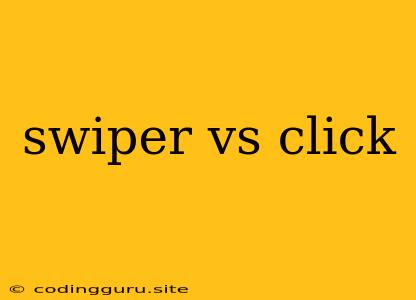Swiper vs Click: Choosing the Right Interaction for Your Web App
In the realm of web development, creating an engaging user experience is paramount. One of the fundamental aspects of this user experience is how users interact with elements on the web page. Two prominent interaction methods that developers often employ are swiping and clicking.
Swiper and click are two distinct ways of interacting with web pages. They offer different advantages and disadvantages, making the choice between them dependent on the specific needs of the application. This article will delve into the intricacies of both interaction methods, comparing and contrasting their suitability for various scenarios.
What is Swiping?
Swiping is a touch gesture commonly found on mobile devices, primarily smartphones and tablets. It involves dragging a finger across the screen in a specific direction, typically left or right, to navigate, interact with elements, or trigger actions.
Advantages of Swiping:
- Intuitive and Natural: Swiping is a natural and intuitive gesture that users are familiar with from their everyday interactions with mobile devices. It allows for smooth and effortless navigation through content, making it a highly engaging interaction method.
- Efficient Navigation: Swiping can streamline navigation through lists, galleries, and other content-heavy sections, enabling users to quickly browse and find what they're looking for.
- Compact and Minimalist: Swiping often eliminates the need for bulky buttons or menus, resulting in a cleaner and more aesthetically pleasing user interface.
Disadvantages of Swiping:
- Limited Desktop Compatibility: While swiping can be implemented on desktop using mouse gestures, it's not as widespread or intuitive as it is on mobile.
- Accessibility Concerns: Swiping can pose accessibility challenges for users with motor impairments or who use assistive technologies.
- Potential for Accidental Swipes: The sensitivity of swiping can sometimes lead to accidental actions, especially when navigating through dense content or with trembling hands.
What is Clicking?
Clicking is a ubiquitous interaction method found on both desktop and mobile devices. It involves pressing a mouse button or tapping on the screen to select or activate an element.
Advantages of Clicking:
- Widely Supported: Clicking is supported across all devices, from desktops to mobile phones, ensuring broad accessibility.
- Precise and Controllable: Clicking provides precise control over actions, allowing users to select specific elements with accuracy.
- Accessibility-Friendly: Clicking is inherently accessible, as it can be easily performed using various input methods, including keyboards, mouse buttons, and touchscreens.
Disadvantages of Clicking:
- Less Natural on Mobile: Clicking on mobile devices can feel less intuitive and less natural than swiping, particularly when navigating through large amounts of content.
- Potential for Cluttered Interfaces: Excessive buttons and clickable elements can lead to a cluttered interface, making it harder for users to find what they need.
- Limited Navigation Flexibility: While clicking can be used for basic navigation, it's less efficient and flexible compared to swiping, especially in situations requiring quick and fluid movement through content.
Swiper vs Click: Choosing the Right Approach
The choice between swiping and clicking ultimately depends on the specific requirements of your web application. Consider the following factors:
- Target Audience and Device Usage: If your primary target audience is mobile users, swiping is often the more appropriate choice, as it aligns with their familiar interaction patterns. However, if your audience primarily uses desktop computers, clicking might be a more suitable option.
- Content Type and Navigation Complexity: For content-heavy applications like image galleries or product listings, swiping can provide a more engaging and efficient navigation experience. However, for applications with less content or complex navigation structures, clicking might be a more reliable choice.
- Accessibility Requirements: Clicking offers better accessibility for users with disabilities, especially those relying on keyboard navigation or assistive technologies.
- User Experience and Aesthetics: Swiping can contribute to a more intuitive and aesthetically pleasing user experience, particularly on mobile devices. However, clicking might be preferable when seeking a more traditional and familiar interface.
Examples:
- Mobile Gallery App: A mobile gallery app that displays a collection of images would be a perfect candidate for swiping. Users can easily navigate through the images by swiping left or right, creating a seamless and engaging experience.
- E-commerce Website: An e-commerce website featuring product listings can utilize clicking for users to select and add items to their carts. While swiping could be used for navigating product categories, clicking provides greater control and precision for individual product selection.
Best Practices:
- Use Swiping Consistently: When implementing swiping in your application, ensure consistency in the direction and functionality of the swipe gesture. Users should intuitively understand how swiping will affect the interface.
- Provide Clear Visual Cues: If you're using swiping for navigation, offer visual cues like arrows or swipe indicators to guide users and prevent confusion.
- Avoid Overuse: Don't overuse swiping, as it can become repetitive and detract from the user experience. Use it strategically for specific actions or navigation elements.
Conclusion
Swiping and clicking are two essential interaction methods in web development. Choosing the right one depends on the context and the specific needs of your application. While swiping offers a natural and engaging experience, particularly on mobile devices, clicking remains a reliable and accessible option for various applications. By carefully considering the factors discussed above, you can select the interaction method that best aligns with your target audience, content type, and overall user experience goals.
